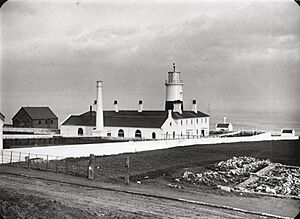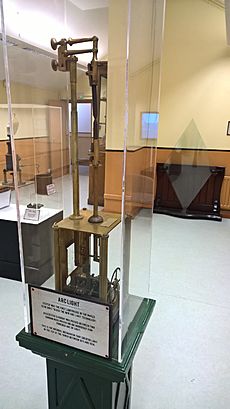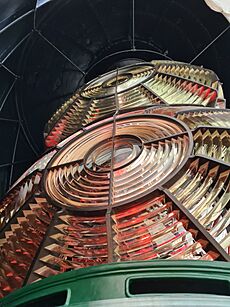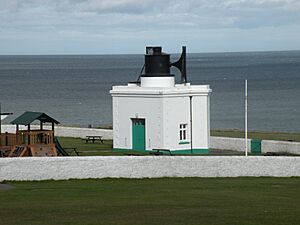Souter Lighthouse facts for kids
| Location | Whitburn, Tyne and Wear |
|---|---|
| Fog signal | One blast every 30s |
Souter Lighthouse is a famous lighthouse located near Whitburn, in South Tyneside, England. When it was working, people often called it Souter Point Lighthouse. This lighthouse was super special because it was the first one in the world built specifically to use alternating electric current. This was the most advanced technology for lighthouses back then!
The light came from a carbon arc lamp. It was first lit on January 11, 1871. At the time, people said it was "without doubt one of the most powerful lights in the world."
After it stopped being used by Trinity House (the main lighthouse authority) in 1988, the National Trust took over Souter Lighthouse. Now, they manage it as a fun place for visitors. You can even stay in some of the old lighthouse keepers' homes!
Contents
Where is Souter Lighthouse?
The lighthouse is actually built on Lizard Point. But it got its name from Souter Point, which is about a mile south. The builders originally planned to put it on Souter Point. However, they realized Lizard Point was better because its cliffs are higher. This meant the light could be seen from much farther away. They kept the name Souter Lighthouse to avoid confusing it with the Lizard Lighthouse in Cornwall, which was built around the same time.
Souter Lighthouse is about three miles south of the River Tyne's mouth. About four miles north of the Tyne's mouth is another old lighthouse, St Mary's Lighthouse. It's on St Mary's Island. St Mary's Lighthouse is also no longer working, but you can visit it. On a clear day, you can even see St Mary's Lighthouse from the top of Souter Lighthouse!
History of Souter Lighthouse
This lighthouse was really important for ships. The waters around it, especially the dangerous reefs called Whitburn Steel, caused many shipwrecks. In just one year, 1860, there were 20 shipwrecks! This part of the coastline was known as the most dangerous in the country. On average, there were about 44 shipwrecks for every mile of coastline.
Building the Lighthouse (1800s)
How it was Built
Trinity House asked their Chief Engineer, James Douglass, to design the lighthouse and its buildings. Henry Norris was the engineer who oversaw the building work on site.
Around the lighthouse tower, several other buildings were put together in a square shape. These included the engine room, a boiler house, and five homes for the lighthouse keepers. All these buildings were made from stone and covered with Portland cement. Building the lighthouse and cottages cost about £8,000. A local company, James Todd, won the contract in March 1869.
The first stone was officially laid on June 9, 1869. The building work finished in 1870, and the lighthouse started working in January 1871. After this project, Douglass and Norris went on to build Hartland Point Lighthouse in Devon.
Electricity at Souter Lighthouse
Carbon arc lights were a new idea for lighthouses. Professor Frederick Hale Holmes was a pioneer in this field. Trinity House tested these lights for five years before deciding to use them at Souter.
The carbon arc lamp at Souter was placed inside a special lens system. This system had a third-order fixed lens surrounded by eight spinning prisms. These prisms made one very bright flash every thirty seconds. The light was so strong, about 800,000 candle power, that it could be seen up to 26 miles away! James Chance designed and built these special lenses in 1870.
There was also a red and white "sector light" that shone from a window lower down in the tower. This light helped warn ships about dangers like Hendon Rock and the White Stones in Sunderland Bay. It used light from the main lamp, redirected by mirrors and lenses.
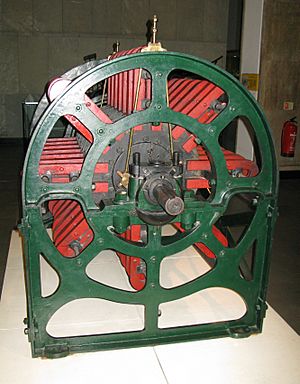
The electricity for the light came from two of Holmes' own magneto electric generators. Usually, only one generator was used. But if the weather was very foggy, both were connected to make the light even brighter. These generators were powered by one of two steam engines made by J. Whitworth & Co. These engines were quite powerful for their time. Before they came to Souter, the engines and generators were shown at a big exhibition in Paris in 1867. The engines worked in turns, one week on and one week off. They were in the engine-house and also powered an air-pump for the foghorn.
In December 1891, the lighthouse tower was painted with a wide red band. This made it easier to see during the day.
The Foghorn
Holmes also designed a reed fog signal for the new lighthouse. It sounded from a separate building east of the tower, through two tall trumpets facing out to sea. It made one blast every 45 seconds. Compressed air for the foghorn traveled underground from the engine room, where the air compressor was powered by the same engines that ran the light.
In February 1879, a more powerful siren fog signal replaced the reeds. This siren sounded one blast every minute. It needed an extra, stronger engine, which was installed in the engine room to power its compressor.
Changes in the 1900s
Switch to Oil Lamps
In 1914, the electric light at Souter, which was so advanced, was replaced. It was changed to the newest type of incandescent oil lamps, which used paraffin vapor. At the same time, Chance Brothers provided a new, much larger lens system. This was a "bi-form" lens, meaning it was double-height and had two lamps, one above the other. A new lantern was also added to fit the taller lens. Red covers were placed around the lamps inside the lenses, so the light now flashed red once every 5 seconds. This 1914 lens system is still in the tower today! It weighs 4.5 tonnes and floats on 1.5 tonnes of mercury.
A separate lamp was used for the fixed red and white sector light, which continued to shine from its window lower down.
The two original electric generators were removed from the engine room. One was given to the Institution of Electrical Engineers in 1915 and is now on display at the Science Museum, London.
The fog signal got better in 1919. A more powerful siren was installed, sounding through two Rayleigh trumpets. The siren gave a 4-second blast every minute. Hornsby oil engines were put in to power the compressors for this new siren.
Back to Electricity
In 1952, the lighthouse was changed back to electric power. This time it used incandescent lamps powered by mains electricity. The main light used very large 4,500-watt bulbs, the biggest used by Trinity House. If the main electricity went out, a diesel generator would start. If that also failed, an emergency battery lamp would turn on. The mechanism that turned the lenses was still clockwork until 1983, when it was replaced by electric motors.
The fog signal was updated again in 1953. A Stone Chance diaphone signal was installed, and two exponential horns replaced the old trumpets on top of the foghorn building. The engine room also got two new Reavell compressor sets. One was powered by an electric motor, and the other by a diesel engine. The diaphone made a five-second blast every 30 seconds in bad weather. It was used until 1988, when the lighthouse stopped working.
When Souter Lighthouse Stopped Working
Souter Lighthouse was officially stopped by Trinity House in 1988. However, it continued to work as a radio navigation beacon until 1999, when it was finally closed down completely.
Souter Lighthouse Today
Souter Lighthouse was never made automatic, meaning people always worked there. Because of this, it still looks very much like it did when it was first built, except for the updates to its light and electrical parts over the years.
Today, the National Trust owns Souter Lighthouse. It's open to the public, so you can visit! You can see the engine room, the light tower, and the homes where the keepers lived. There's also an outdoor play area and indoor activities for younger visitors. Two of the old lighthouse keepers' cottages are now holiday homes you can rent from the National Trust. The lamps, lenses, and foghorn still work and are sometimes turned on for special events!
Gallery
See also
- List of lighthouses in England
- Grade II* listed buildings in Tyne and Wear


